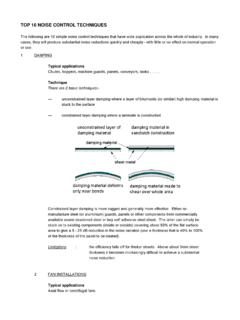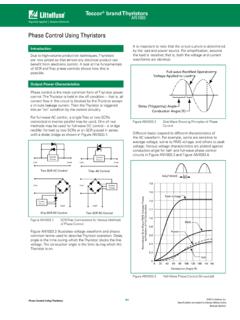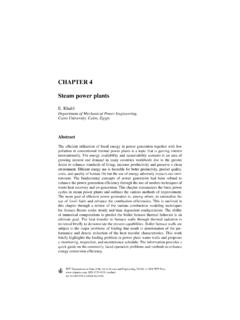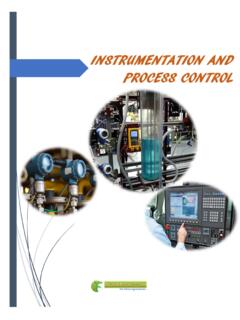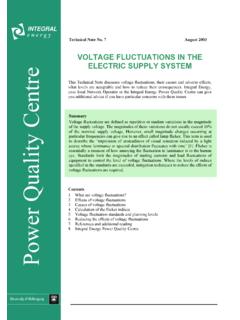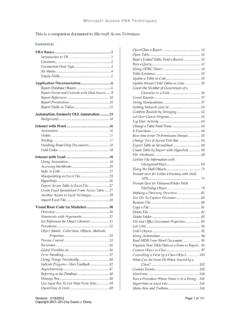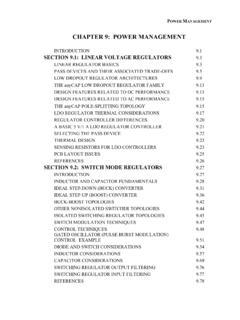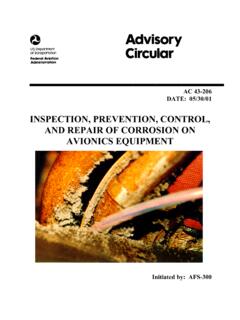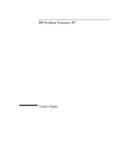Transcription of Quality control: Meaning, process control, SQC control ...
1 Unit 4 Notes By Neha Chhabra Quality control : Meaning, process control , SQC control charts, single, double and sequential sampling, Introduction to TQM. Quality control DEFINITION OF Quality : The meaning of Quality is closely allied to cost and customer needs. Quality may simply be defined as fitness for purpose at lowest cost. The component is said to possess good Quality , if it works well in the equipment for which it is meant. Quality is thus defined as fitness for purpose. Quality is the totality of features and characteristics both for the products and services that can satisfy both the explicit and implicit needs of the customers. Quality of any product is regarded as the degree to which it fulfills the requirements of the customer. Quality means degree of perfection. Quality is not absolute but it can only be judged or realized by comparing with standards. It can be determined by some characteristics namely, design, size, material, chemical composition, mechanical functioning, workmanship, finish and other properties.
2 MEANING OF control control is a system for measuring and checking (inspecting) a phenomenon. It suggests when to inspect, how often to inspect and how much to inspect. In addition, it incorporates a feedback mechanism which explores the causes of poor Quality and takes corrective action. control differs from inspection , as it ascertains Quality characteristics of an item, compares the same with prescribed Quality standards and separates defective items from non-defective ones. Inspection, however, does not involve any mechanism to take corrective action. MEANING OF Quality control Quality control is a systematic control of various factors that affect the Quality of the product. The various factors include material, tools, machines, type of labour, working conditions, measuring instruments, etc. Quality control can be defined as the entire collection of activities which ensures that the operation will produce the optimum Quality products at minimum cost.
3 As per Feigorbaum Total Quality control is: An effective system for integrating the Quality development, Quality maintenance and Quality improvement efforts of the various groups in an organization, so as to enable production and services at the most economical levels which allow full customer satisfaction In the words of Alford and Beatly, Quality control may be broadly defined as that Industrial management technique means of which products of uniform accepted Quality are manufactured. Quality control is concerned with making things right rather than discovering and rejecting those made wrong. In short, we can say that Quality control is a technique of management for achieving required standards of products. FACTORS AFFECTING Quality In addition to men, materials, machines and manufacturing conditions there are some other factors which affect the product Quality . These are: Market Research indepth into demands of purchaser.
4 Money capability to invest. Management Management policies for Quality level. Production methods and product design. Modern Quality control begins with an evaluation of the customer s requirements and has a part to play at every stage from goods manufactured right through sales to a customer, who remains satisfied. OBJECTIVES OF Quality control To decide about the standard of Quality of a product that is easily acceptable to the customer and at the same time this standard should be economical to maintain. To take different measures to improve the standard of Quality of product. To take various steps to solve any kind of deviations in the Quality of the product during manufacturing. FUNCTIONS OF Quality control DEPARTMENT Only the products of uniform and standard Quality are allowed to be sold. To suggest method and ways to prevent the manufacturing difficulties. To reject the defective goods so that the products of poor Quality may not reach to the customers.
5 To find out the points where the control is breaking down and to investigate the causes of it. To correct the rejected goods, if it is possible. This procedure is known as rehabilitation of defective goods. ADVANTAGES OF Quality control Quality of product is improved which in turn increases sales. Scrap rejection and rework are minimized thus reducing wastage. So the cost of manufacturing reduces. Good Quality product improves reputation. Inspection cost reduces to a great extent. Uniformity in Quality can be achieved. Improvement in manufacturer and consumer relations. STATISTICAL Quality control ( ): Statistics: Statistics means data, a good amount of data to obtain reliable results. The science of statistics handles this data in order to draw certain conclusions. : This is a Quality control system employing the statistical techniques to control Quality by performing inspection, testing and analysis to conclude whether the Quality of the product is as per the laid Quality standards.
6 Using statistical techniques, collects and analyses data in assessing and controlling product Quality . The technique of was though developed in 1924 by American scientist; it got recognition in industry only second world war. The technique permits a more fundamental control . Statistical Quality control can be simply defined as an economic & effective system of maintaining & improving the Quality of outputs throughout the whole operating process of specification, production & inspection based on continuous testing with random samples. -YA LUN CHOU Statistical Quality control should be viewed as a kit of tools which may influence decisions to the functions of specification, production or inspection. -EUGENE L. GRANT The fundamental basis of is the theory of probability. According to the theories of probability, the dimensions of the components made on the same machine and in one batch (if measured accurately) vary from component to component.
7 This may be due to inherent machine characteristics or the environmental conditions. The chance or condition that a sample will represent the entire batch or population is developed from the theory of probability. Relying itself on the probability theory, evaluates batch Quality and controls the Quality of processes and products. uses three scientific techniques, namely; Sampling inspection Analysis of the data, and control charting ADVANTAGES OF is one of the tool for scientific management, and has following main advantages over 100 percent inspection: Reduction in cost: Since only a fractional output is inspected, hence cost of inspection is greatly reduced. Greater efficiency: It requires lesser time and boredom as compared to the 100 percent inspection and hence the efficiency increases. Easy to apply: Once the plan is established, it is easy to apply even by man who does not have extensive specialized training.
8 Accurate prediction: Specifications can easily be predicted for the future, which is not possible even with 100 percent inspection. Can be used where inspection is needs destruction of items: In cases where destruction of product is necessary for inspecting it, 100 percent inspection is not possible (which will spoil all the products), sampling inspection is resorted to. Early detection of faults: The moment a sample point falls outside the control limits, it is taken as a danger signal and necessary corrective measures are taken. Whereas in 100 percent inspection, unwanted variations in Quality may be detected after large number of defective items have already been produced. Thus by using the control charts, we can know from graphic picture that how the production is proceeding and where corrective action is required and where it is not required. process control Under this the Quality of the products is controlled while the products are in the process of production.
9 The process control is secured with the technique of control charts. control charts are also used in the field of advertising, packing etc. They ensure that whether the products confirm to the specified Quality standard or not. process control consists of the systems and tools used to ensure that processes are well defined, performed correctly, and maintained so that the completed product conforms to established requirements. process control is an essential element of managing risk to ensure the safety and reliability of the Space Shuttle Program. It is recognized that strict process control practices will aid in the prevention of process escapes that may result in or contribute to in-flight anomalies, mishaps, incidents and non-conformances. The five elements of a process are: People skilled individuals who understand the importance of process and change control Methods/Instructions documented techniques used to define and perform a process Equipment tools, fixtures, facilities required to make products that meet requirements Material both product and process materials used to manufacture and test products Environment environmental conditions required to properly manufacture and test products process control SYSTEMS FORMS process control systems can be characterized as one or more of the following forms: Discrete Found in many manufacturing, motion and packaging applications.
10 Robotic assembly, such as that found in automotive production, can be characterized as discrete process control . Most discrete manufacturing involves the production of discrete pieces of product, such as metal stamping. Batch Some applications require that specific quantities of raw materials be combined in specific ways for particular durations to produce an intermediate or end result. One example is the production of adhesives and glues, which normally require the mixing of raw materials in a heated vessel for a period of time to form a quantity of end product. Other important examples are the production of food, beverages and medicine. Batch processes are generally used to produce a relatively low to intermediate quantity of product per year (a few pounds to millions of pounds). Continuous Often, a physical system is represented through variables that are smooth and uninterrupted in time. The control of the water temperature in a heating jacket, for example, is an example of continuous process control .
